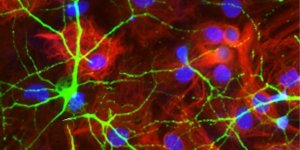| News / Science News |
Exploding Stars Make Key Ingredient in Sand, Glass
A new study using observations by NASA's Spitzer Space Telescope reports for the first time that silica - one of the most common minerals found on Earth - is formed when massive stars explode.

This image of supernova remnant G54.1+0.3 includes radio, infrared and X-ray light. The blue and green emissions show the presence of dust, including silica. Photo: NASA/JPL-Caltech/CXC/ESA/NRAO/J. Rho (SETI Institute)
A major component of many types of rocks on Earth, silica (silicon dioxide, SiO2) is used in industrial sand-and-gravel mixtures to make concrete for sidewalks, roads and buildings.
One form of silica, quartz, is a major component of sand found on beaches along the U.S. coasts. Silica is a key ingredient in glass, including plate glass for windows, as well as fiberglass. Most of the silicon used in electronic devices comes from silica.
In total, silica makes up about 60 percent of Earth's crust. Its widespread presence on Earth is no surprise, as silica dust has been found throughout the universe and in meteorites that predate our solar system.
One known source of cosmic dust is AGB stars, or stars with about the mass of the Sun that are running out of fuel and puff up to many times their original size to form a red giant star. (AGB stars are one type of red giant star.)
But silica is not a major component of AGB star dust, and observations had not made it clear if these stars could be the primary producer of silica dust observed throughout the universe.
The new study reports the detection of silica in two supernova remnants, called Cassiopeia A and G54.1+0.3.
A supernova is a star much more massive than the Sun that runs out of the fuel that burns in its core, causing it to collapse on itself. The rapid in-fall of matter creates an intense explosion that can fuse atoms together to create "heavy" elements, like sulfur, calcium and silicon.
The new work implies that the silica produced by supernovas over time was significant enough to contribute to dust throughout the universe, including the dust that ultimately came together to form our home planet.
The study confirms that every time we gaze through a window, walk down the sidewalk or set foot on a pebbly beach, we are interacting with a material made by exploding stars that burned billions of years ago. (NASA)
YOU MAY ALSO LIKE



